This next section is a continuation of “How the heart and the blood really operate,” from Part II.
Let’s deconstruct some potential causes of poor blood supply, so we can understand them and find out what might be required to fix them.
Excessive friction
Negation of friction is the first fundamental of blood that flows freely. For this to be accomplished, red blood cells have to be surrounded by a cloud of charged particles that contain more electrons than protons. The polarity of charged particles keeps blood from sticking to vessel walls and to each other. Equally integral to the blood’s hydrodynamic efficiency, protons from the formation of e-zone unify the blood so cells and fluid move with an affinity for each other.
So what would happen if zeta potential drops and friction rises? Poor blood flow, oxygenation, metabolism, hormone function, and detoxification would be the obvious effects. The body would then raise blood pressure by constricting the vessels in order to increase flow rate at the expense of volume. When blood is not moving well, the vessels take whatever momentum is available in the blood and project it into fewer RBCs – basically concentrating their investment into fewer cells.
Inelastic blood vessels
The smooth muscle fibers of blood vessels are encased interiorly and exteriorly by an elastic membrane, called the “internal and external elastic lamina,” respectively. These smooth muscles contract and relax to control vessel diameter and blood pressure. But what happens, according to Dr. Jerry Tennant’s working theory, is that intrusion of fluoride breaks down collagen and elastin fibers of the elastic lamina that are supposed to limit the movement of smooth muscles like a netting.
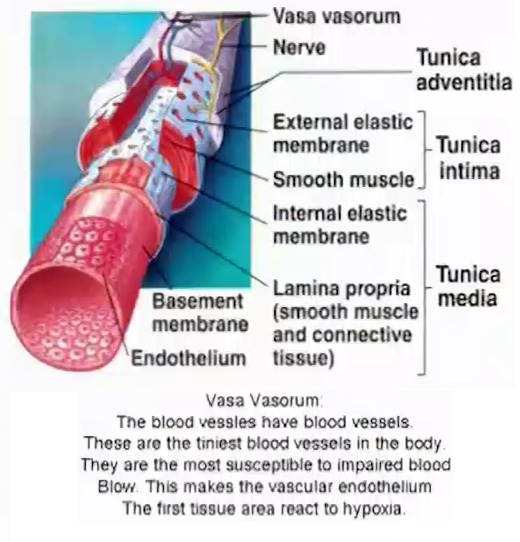
Without the restriction of this netting, the smooth muscles are then free to overstretch themselves. Dr. Tennant believes this creates wounds in the vessel, which the body tries to repair with cholesterol, which becomes an arterial plaque. My guess is, Dr. Bonlie’s theory of plaque buildup is more accurate (or more prominent), in which heavy metals and their positive charge break down the glycocalyx and falsely attract repair processes, including cholesterol.
In either case, the point to consider here is that breakdown of the elastic lamina would impair the ability of blood vessels to expand and contract, thus hindering the pumping action of the vessels – whether the vessels’ elasticity is designed to actively do the work of pumping the blood or is just a passive reaction. If fluoride weakens the elastic lamina to the point of incompetence, elasticity of the vessels is certain to be compromised and, along with it, blood flow.
What would the body do then? Unable to expand and contract on-demand, the body might keep the arteries constricted permanently (and thus unresponsive). We would see this situation expressed as high blood pressure and/or narrow arteries. Calcified arteries also make the arteries inelastic. So whether fluoride damages vessel walls on the way to being repaired with cholesterol, or lead and mercury cause a calcified plaque, both scenarios result in a loss of vessel elasticity that cuts down that input of energy (propulsion) into the system, thereby making blood flow less efficient.
Poorly structured blood flow
Blood flow must pulsate as it leaves the heart, and it must spiral, to give blood the boost it needs to avoid losing too much momentum through the capillary bed. Both stem from the hydraulic ram effect centered around the closing and opening of the heart valves. Breaks in the flow generate pulses of pressure, which leave the valves in a helical pattern that reduces friction and consolidates energy.
The centripetal acceleration of vortexing preserves kinetic energy present in the blood. And it is thought to bring more energy into our 3-D space at the moment blood flow is halted by the closing of the valves – like squeezing small amounts of energy into this realm by condensing matter. It’s not a lot, but it is enough to keep total momentum of the bloodstream at breakeven (resting, sustainable) or better (athletic, resilient). That’s how I would describe the roles of pulsation and vortexing in the efficiency of blood flow.
Unfortunately, when body parts such as vessels, valves or heart muscles deteriorate, you get corrective measures like high blood pressure, congestive heart failure (thickening of heart muscles), or inflammation. Hopefully, now you recognize how most anatomical changes are preceded by a decay in your biophysical state – meaning electrical charge, magnetism, light, water and mitochondria.
Impotent exclusion zone (e-zone)
When it’s hot out, your circulatory system needs less help delivering a decent amount of blood because you’re collecting more energy from your environment. Infrared light builds more e-zone in blood vessels which adds polarity and propulsion to the blood, at a time when UV light is increasing flow volume by dilating vessels with nitric oxide.
On the other hand, when you get cold, or when your internal biophysics are off, the circulatory system goes into adaptation mode because you don’t have the zeta potential to delete friction with electrons, and help propel the blood with protons. What does the body do then to compensate for a low-flow situation? It constricts the vessels to keep the blood’s momentum up.
Similarly, when your extremities get cold, those vessels shrink to minimize heat loss. When IR exposure drops low enough – both exogenously and endogenously – vessels close and blood flow ceases entirely. But did the blood stop flowing because the vessels were closed off? Or did the vessels shut down because there was no IR-induced e-zone to keep them open (i.e., charged particles, friction negation, propulsion, and cohesion of the blood)?
My answer would be the former, while the latter seems more likely to be a coincidence of complimentary factors. But it is an interesting whodunnit. E-zone is probably one of the body’s main contributors to zeta potential and blood flow, but more research is needed to determine what roles they do play in the efficiency of blood flow.
Consider a similar condition of great significance to millions: A shortage of charged particles has got to play a major role in poor circulation in diabetics (aka “peripheral artery disease”). Is low polarity, propulsion and cohesiveness to blame for poor circulation in our diabetic population?
I would be shocked if the factors I’m laying out here were not a whole lot closer to the truth than the cooked-up stories about bad fats blocking up arteries and causing neuropathy (nerve damage), nephropathy (kidney disease), and retinopathy (eye damage). Even high blood-sugar probably doesn’t directly damage nerves as much as it weakens zeta potential, e-zone, and ultimately blood flow.
Arterial plaque
I can’t prove it but, based on the way Nature operates, I wouldn’t be surprised if narrowing of the arteries was sometimes employed by the body on purpose to keep the blood’s velocity up when it gets sluggish – basically putting the blood’s momentum into fewer cells in an effort to maintain the hydrodynamic efficiency of the circulatory system.
Cholesterol and saturated fats do not cause heart disease
Awake and aware observers know that cholesterol and saturated fats, such as animal fats, have nothing to do with clogged arteries. Eating natural fats simply does not cause heart disease. In fact, people who have low blood-cholesterol levels are at increased risk of diseases involving: the heart, the brain and nervous system, mood and behavior (from inability to make hormones and neurotransmitters), metabolism, infertility and libido, as well as the maintenance and repair of cells. …And the whole story about “good cholesterol vs. bad cholesterol” = pure fiction.
Colloids (aka colloidal suspensions) and zeta potential
“Intravascular coagulation is both explainable and preventable – but only in term of physical chemistry and basic concepts of zeta potential.” — Thomas M. Riddick.
A majority of substances we think of as being liquid are, in fact, colloids. Colloid: A mixture of particles in fluid that: (1) are very small, (2) stay evenly distributed throughout (don’t settle), and (3) do not chemically combine to create new molecules. Everyday examples of a colloid are milk, muddy water, and wet paint. You can also think of colloids as liquid-solid systems.
Colloids, or colloidal suspensions as they are also called, are composed of particles that reach an equilibrium between their attractive and repulsive forces, thus their particles stay suspended without settling. Most important, the stability of a colloid depends on the strength of electrostatic charge around its particles. That is, the higher the (usually negative) charge around its particles, the more resistant that colloid is to separating its ingredients into fractions via gravity or centrifugation.
To unpack that further, particles typically each have a charge on their surface that attracts a dense layer of smaller particles of the opposite charge. This base layer of “ions,” as charged particles are called, attracts a second layer of loosely-packed ions from solution. The sum total charge of these two layers, compared to the surrounding “bulk” solution, is what we call “zeta potential.” Simply put, zeta potential is the electrical charge around particles (its double layer) that give a liquid-solid system properties such as fluidity/viscosity or attraction/repulsion.
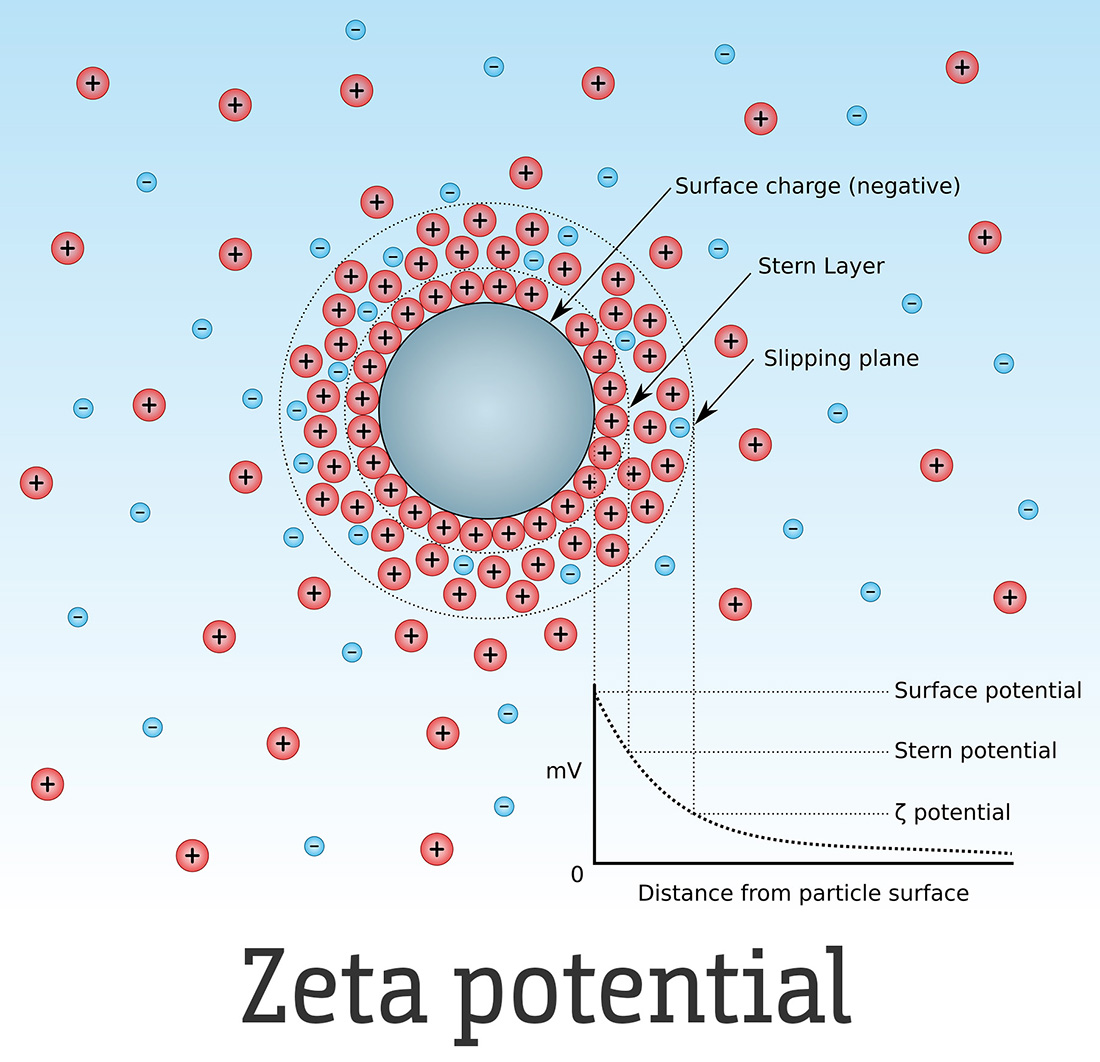
Author: Larryisgood, modified by Mjones1984. Zeta potential: A theory of coagulation and dispersion developed in 1879 by German physicist Hermann von Helmholtz. Note: The particle in this image is depicted to be carrying a net-positive zeta potential, whereas most colloids, including human blood, are net negative.
Thomas M. Riddick describes zeta potential
“All trace metals, minerals, inorganic materials, proteins and amino acids are held in suspension – not solution – in liquids by an electrical charge. These very small particles are called colloids and are too small to see with the naked eye. Since colloids in suspension form chemical compounds (like ions in solution), the electrical properties of colloids are generally ignored. In liquids, the ability to carry material in suspension is a function of these minute electrical charges.
As the negative charge increases, more material can be carried in suspension. As the charge decreases, the particles move closer to each other and the liquid is able to carry less material. There is a point where the ability to carry material in suspension is exceeded and particles begin to clump together, with the heavier metals or more positively-charged colloids dropping out of the liquid and coagulating.”
Dr. Mark Sircus
“Electrical force, blood pH and zeta potential are parallel concepts but no matter which word you choose (even blood chi) the crucial point is that these electrical and thus magnetic characteristics’ (controlled by blood pH) strength determines the amount of material (nutrients, wastes) that our blood and lymph can carry. Increasing the pH in the solution allows the fluid to dissolve and hold more material. In this way, more nutrients can be carried throughout your body and accumulated deposits of waste can be removed.
Acidic blood carries a positive charge, and alkaline blood carries a negative charge. One of the side effects of acidic blood is to reduce the negative charge of colloids (combinations of molecules held in suspension) causing them to fall out of suspension, thereby coagulating on the walls of the arteries, similar to scale forming in a pipe. When it happens in an artery, we call it arteriolosclerosis.”
Now let’s talk about blood, as an example
First facts to know about blood: All blood cells (e.g., red, white, platelets) are slightly heavier than the liquid fractions such as plasma. That’s why red blood cells settle to the bottom when blood is centrifuged. Therefore, blood requires appropriate levels of electrostatic charge on its cells to be fully functional whole blood. Otherwise, cells and plasma would not be a team; they would act independently.
In a healthy state, red blood cells (erythrocytes) carry a negative charge at their surface (article abstract). Positive ions from the serum (plasma without the clotting factors), envelope the RBCs with a base coat, which are encircled by another layer, resulting in what should be a net negative double layer of zeta potential. The higher this negative charge, the freer-flowing the blood is, thus the healthier you can be. It’s this double layer of net-negative charge, relative to the surrounding fluid, that acts as a lubricant.
Zeta potential makes RBCs slippery against each other and the vessel walls. However, when RBCs lose their charge, they stick to each other and the vessel walls. That’s because red blood cells are made of sticky glycoproteins. So when RBCs lack negative charge, their natural tendency is to lose their oneness with whole blood, fall out of suspension, stick to things in the circulatory system, and form aggregates. Super simply, strong negative charge makes blood thin and easy-flowing like red wine. Whereas, decreased negative charge makes blood thicker and stickier like maple syrup.
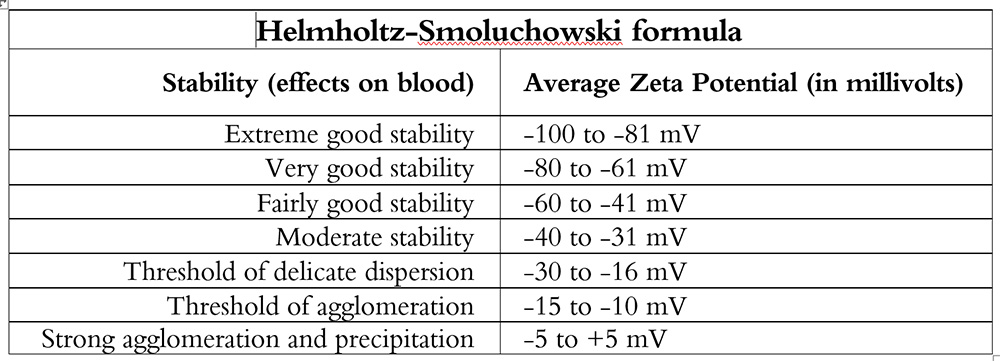
Figures from “Control of Colloid Stability through Zeta Potential” by Thomas M. Riddick.
Colloidal stability is crucial for biologic function, so almost every surface in the body is negatively-charged in order to interact properly with the negative charge of the body’s colloidal fluids, including blood. Bad for biology though, the (negative) surface charge of the glycocalyx attracts (positive) spike proteins and toxins to it.
Substack author, A Midwestern Doctor (from their article “What Makes All Vaccines So Dangerous?”)
“I have observed a variety of therapies that restore zeta potential benefit both individuals with COVID-19 and those with spike protein vaccine injuries, sometimes to a minor extent, and sometimes to the point they fully resolved an otherwise fatal disease process (the exact result largely depends on the specific therapy utilized and the exact issue the patient has).”
Thomas M. Riddick
An early pioneer in the use of zeta potential was an engineer and chemist named Thomas M. Riddick (1907–1975). His consulting firm recommended ways to improve the dynamic properties of colloidal suspensions that he and his clients worked with. For example, clays are colloidal suspensions that must be kept stable. Otherwise, the solids can clump together and clog transport pipes.
Similarly, sewage has dramatically different properties in colloidal form than as separate solids and liquids. With waste water, it helps to reduce its colloidal stability (called “flocculating”) so that organic matter separates from water, thereby making the sludge easier to collect and dispose of.
Today, the instruments Riddick developed are used in the fields of atomic energy, medical research, petroleum, petrochemicals, pulp and paper, pharmaceuticals, aluminum, cosmetics, latex, asphalt, paint, and fibers, as well as in water and waste treatment plants.
Of several factors you can change to manipulate a colloid’s stability, zeta potential is easiest and most potent, and was therefore the primary focus of Riddick’s work. He found that a compound’s ability to pull electrons from a colloid exponentially increases according to its valence charge. You can think of this as oxidizing a colloid’s zeta potential
For instance, aluminum, which carries a +3 valence charge, has far greater electron-stealing (sludging) capacity than sodium (Na+), which carries a +1 charge. Therefore, when Riddick wanted to agglutinate/flocculate a colloid’s solids (as a water treatment plant would), he used a +3 aluminum compound, instead of a +2 calcium or +1 sodium compound.

Around 1880, Schultz and Hardy’s guesstimate was that each jump up or down in a compound’s valence charge resulted in a 10 to 100 times difference in attraction or repulsion between particles. Valence charge is also much stronger than an equal number of counter-balancing atoms at a lower valence. For example, the (trivalent, +3) aluminum cation in AlCl3 exerts much great influence than three monovalent anions of chlorine (each -1) in a colloidal system. (Cations are elements/compounds with a positive valence charge. Anions are the opposite: negative ions.)
Real example: A colloid of silica in distilled water, called Minusil, can be depleted of zeta potential by 3-4 parts-per-million of AlCl3 (+3 valence), 10,000 ppm of CaCl2 (+2 valence), or 25,000 ppm of a generic +1 valence compound. Notice how potent aluminum is at draining zeta potential: it’s 2,500 times as strong as a +2 ionic compound.
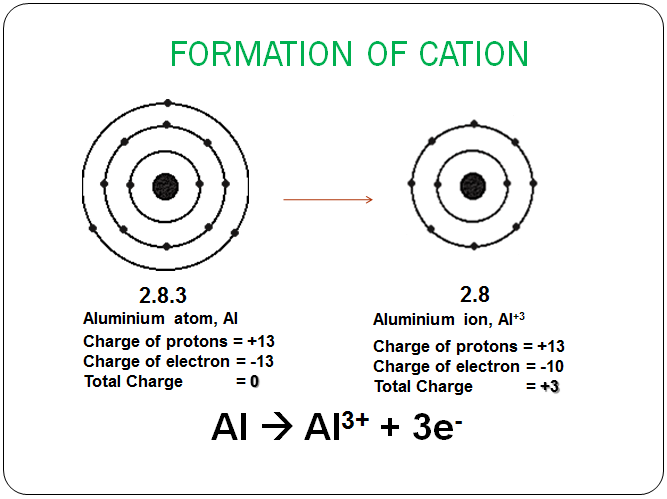
The above diagram shows that the 3rd orbital of aluminum can carry three electrons, for a neutral valence charge of 0. Or it can give up those electrons, resulting in a cation of +3 valence charge.
Conversely, when Riddick wanted particles in a colloid to disperse, he used strong (negative) anions such as phosphate, citrate, or sulfate to increase colloidal stability. Not coincidentally, biology and medicine use negatively-charged (anionic) compounds for the same reason: they donate electrons to increase colloidal stability.
Sulfate, for example, is the active ingredient in heparin. Heparin has the highest negative charge density of any compound used by/in the body. It even coats the surface of many tissues, notably the glycocalyx. These are reasons why heparin is used extensively in hospitals as an anticoagulant, though it’s more accurate to call it a dispersant.
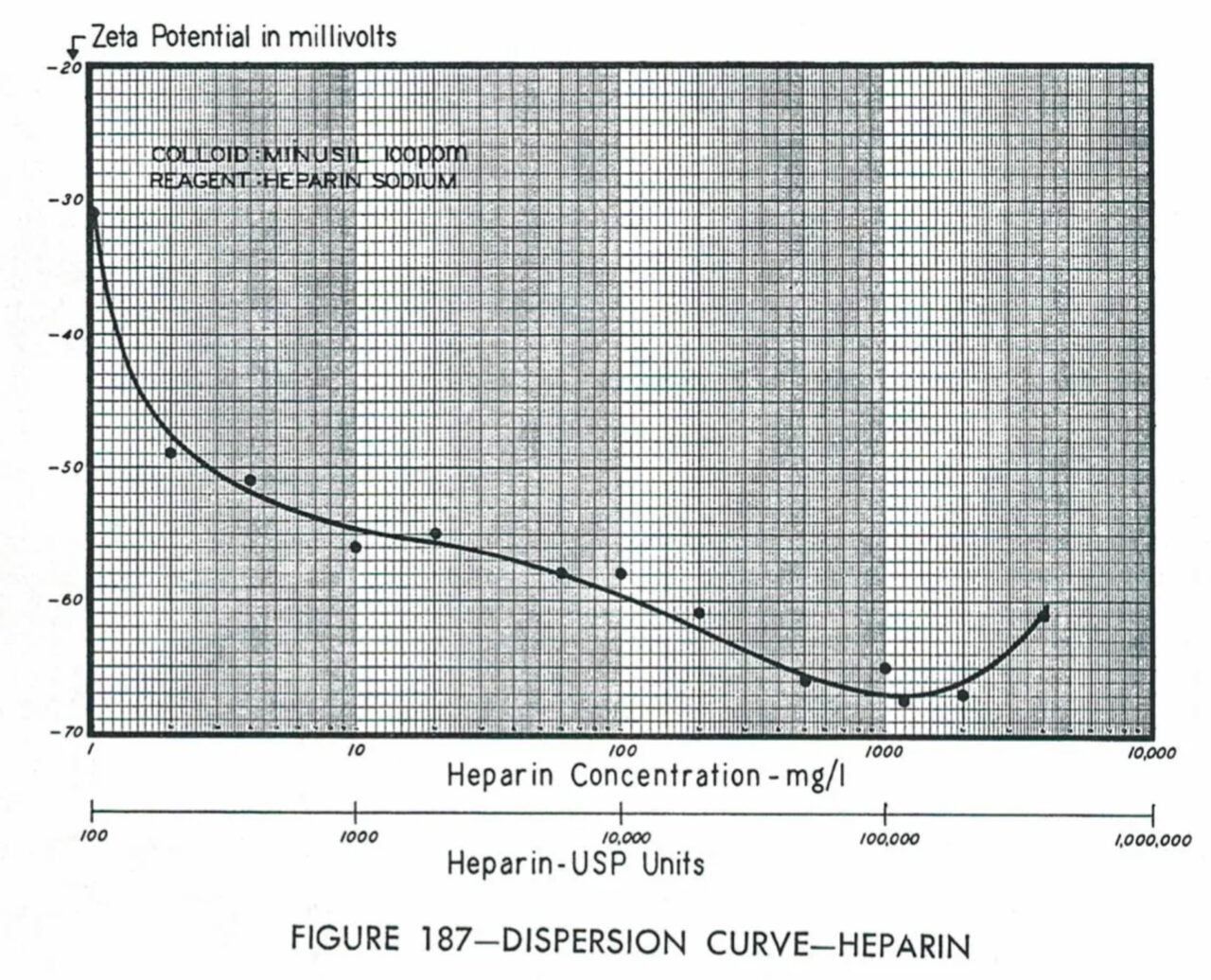
Source: “Control of Colloid Stability through Zeta Potential” by Thomas M. Riddick.
A key function of sulfates may be to form zones of charge-separated, gel-state water (“e-zone,” as I call it – short for “exclusion zone” water). Consistent with that, an important role of sunlight is that it synthesizes sulfates and nitric oxide to improve blood flow. By donating elections, sulfates increase zeta potential of the blood and size of exclusion zone on cell surfaces, while nitric oxide dilates blood vessels. Therefore, vitamin D, while helpful supplementally, is a poor substitute for full-spectrum sun exposure.
Read Dr. Stephanie Seneff’s excellent paper “Sulfate’s Critical Role for Maintaining Exclusion Zone Water: Dietary Factors Leading to Deficiencies” (2019) to learn more about how charge-separated water envelops and powers proteins, cells and vessel walls. Link here.
Loss of zeta potential may cause protein misfolding errors
To make proteins, amino acid chains get folded into complex shapes looking somewhat like a liquid soap loofah or a crumpled piece of paper. To do its job correctly, each protein must have a distinct three-dimensional configuration which must be fully hydrated to keep its shape. Otherwise, it gets bent out-of-shape and malfunctions.
As a result, most proteins form colloidal suspensions that depend on electrostatic attraction or repulsion of their sections to maintain their proper shape. In parallel with that, some spots on amino acid chains are hydrophilic, while others are hydrophobic. This helps the protein bend with the right segments facing either inward or outward, thus retaining the right “conformational” shape, as scientists call a protein’s configuration.
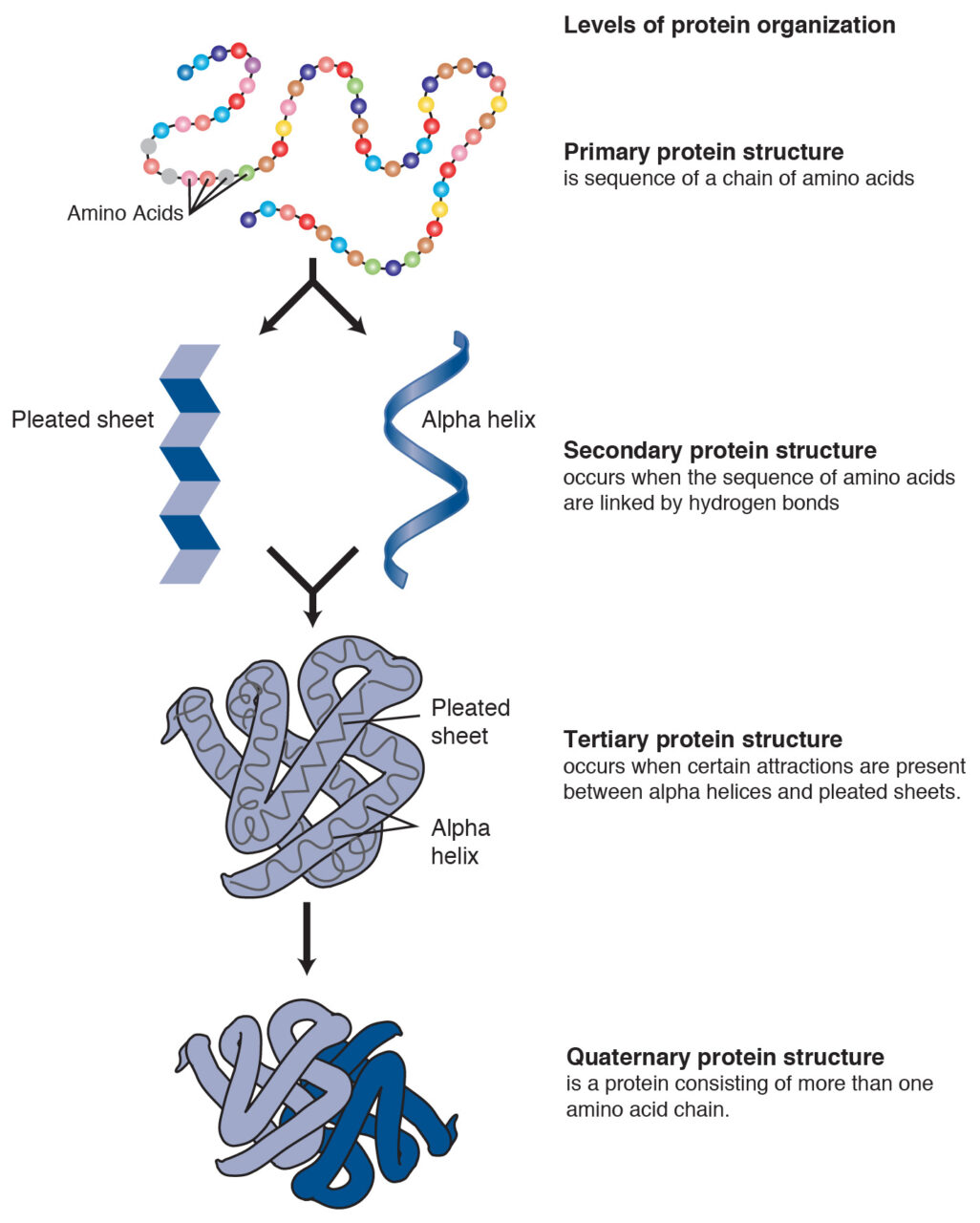
Image credit: The National Human Genome Research Institute (NIH).
In 1888, Franz Hoffmeister showed how various substances either stabilized proteins or denatured them (make them unwind). His findings correlate with research presented herein about the effects of ionic compounds on zeta potential. That is, ionic compounds that deplete zeta potential can also cause proteins to misfold and malfunction. A Midwestern Doctor and I believe this is a clear-cut reason why aluminum is strongly linked to Alzheimer’s. Alzheimer’s plaques are misfolded proteins which typically hoard aluminum.
This may also explain the association between the SARS-CoV-2 spike protein and three conditions involving protein misfolding: amyloidosis, prion diseases and atypical blood clots. That is, spike proteins deplete zeta potential – causing proteins to misfold and malfunction, like those associated with (1) abnormal protein deposits around the body (amyloidosis), (2) brain degeneration such as mad-cow disease for humans (prion disease or Creutzfeldt-Jakob Disease), and (3) normal clotting processes that have run amok (this would explain the long, white, rubbery clots embalmers are seeing in 60-75% of the deceased, after receiving a COVID-19 vaccine).
Riddick himself suffered from cardiovascular problems
This was what led him to wonder whether whole blood is a colloidal suspension of red blood cells in plasma, and therefore must follow the same rules as the industrial applications he worked with. Over time, he became convinced that blood sludging is indeed electrostatic in nature and, by using anionic dispersants like those he used professionally, he could reverse sludging of the blood.
He spent the last fifteen years of his life trying to figure out how to solve his own cardiovascular issues, resulting in significant advancements being made to colloidal science and zeta potential for industry and biology. For example: In addition to negatively-charged chemical compounds like those in the graphic above, Riddick was able to restore lost zeta potential using agents such as raw egg albumin (proteins found in egg whites, aka ovalbumin) in distilled water.
He found that ovalbumin stabilized the blood’s zeta potential against aluminum chloride (AlCl3). As the dosage of aluminum chloride was increased in an in vitro human model, zeta potential didn’t change until the “buffering” action of ovalbumin was exhausted. Once ovalbumin’s protective capacity was depleted by progressively higher dosages of AlCl3, zeta potential quickly dropped to zero and massive agglomeration took place.
This, he believed, is the reason that extremely potent cationic compounds (+3 valence) such as AlCl3 are not immediately fatal: the body has defense mechanisms similar to ovalbumin. Riddick was impressed that ovalbumin could increase the blood’s resistance to coagulation from AlCl3 by a factor of more than 100. He felt these experimental results were replicated elsewhere in nature, including the human body, with its own similar proteins such as albumin.
Riddick’s research led him to think that blood cell agglomeration precedes actual clotting. This is a crucial distinction to make because treating poor blood flow at the clumping stage with zeta-enhancing therapies is so much easier and less risky than trying to break up clots after rigid clots start causing overt disease.
The body continuously manages zeta potential
One of the key take-aways from blood flow research is that the body tries to keep the blood’s zeta potential just far enough on the safe side of the dispersion/agglomeration threshold to keep the blood flowing, but not too thin. The dividing line is about -15 mV.
Maintaining adequate dispersion capacity is a priority in most of nature’s liquid-solid systems – meaning, not too dispersed and not sludgy. The body does this to support the speed and strength of the clotting process, whenever blood leaves the circulation (the vessels themselves increase zeta potential by contributing materials and power transduction).
Other examples: Dispersion is needed in urine because peeing solids (crystals) can’t be fun. Lymphatic fluids need colloidal stability to transport captured toxins out of the body. Unfortunately for us, modern exposures such as aluminum, spike proteins, sugar, a sedentary lifestyle, smoking, alcohol, and non-native EMFs erode the zeta potential of blood while it’s still in the body – leading to blood flow problems that may go unnoticed or undiagnosed.
On the other hand, if your zeta potential is too strong (overdosing on blood thinners would be one reason), you end up with blood that’s too thin – putting you at risk for bleeding that doesn’t stop and injuries that won’t heal. Specifically, the risk of hemorrhaging increases dramatically when blood is slow to clot (i.e., dispersive capacity is too high).
To manage unproductive clotting – like when an incision won’t stop bleeding after surgery – doctors can apply aluminum chloride to increase clotting by agglomerating the blood. Using the same effect, aluminum is the primary ingredient in antiperspirants because it causes perspiration to coagulate and block the pores of sweat glands. In fact, antiperspirants, by the FDA’s definition, must contain aluminum.
As he explored further, Riddick found that the amount of blood sludging and loss of zeta potential varied significantly from person to person, and that Knisely’s grading scale of blood flow in the eyes accurately predicted who was at risk for arrhythmia, stroke, or a fatal heart attack. Even better, Riddick learned that when colloidal stability of the blood was restored, arrythmias improved and circulatory problems got better.
Critical for diabetics to know, Riddick discovered that a primary function of the kidneys is to excrete cations (particles of positive charge). Excessive cations in the blood can trigger cardiac episodes, which the kidneys work desperately to avoid. However, as you age, your kidneys lose proficiency at maintaining zeta potential. Dr. Moulden strongly suspected this loss of efficiency was caused by microclots blocking blood flow through watershed areas of the kidneys.
For his part, Knisely produced videos showing sludging cutting the kidney’s blood flow by 50%, thereby plugging up half its filtration capacity. That means as an individual ages, they lose the ability to handle rapid influxes of positive charge. Therefore, a key component of aging is the gradual decline in the kidneys’ ability to rebalance a harmful zeta level, which maintains circulation.
Aluminum, aluminum everywhere
As Riddick looked around for threats to zeta potential that caused the problems he saw in eye exams, he realized that they’re everywhere, particularly cations in the food supply, including
- Sodium in processed food, instead of potassium.
- Aluminum in water treatment systems.
- Aluminum in cookware.
- Aluminum in foods. For example, aluminum is added to refined salt as an anticaking agent. A Midwestern Doctor believes this is a major reason why mainstream medicine demonizes salt: aluminum additives intensify cardiovascular problems.
- Many pharmaceuticals such as antacids contain aluminum and other cations.
- Aluminum containers can leach cations into food, especially acidic foods. Riddick did experiments that showed drinking water from aluminum storage containers substantially decreased microcirculation.
In case it wasn’t obvious, Riddick ‘feels strongly that “trivalent ions” (such as aluminum) and “salting out” (high-concentration “precipitation”) play by far the most important role in the overall problem of blood stability and cardiovascular disease.’ To put it even more emphatically, aluminum exposure is an extreme insult to your zeta potential. Daily exposure to it – like drinking from an unlined aluminum water bottle every day – can give you coagulation, clots, and heart problems such as heart attack.
Actual example: After drinking from an aluminum water dish for five years, Riddick’s parrot Koko suddenly got cold feet from poor circulation, it lost its chest feathers, and stopped flying. Forty-eight hours after swapping out its pitted aluminum water dish and giving it a dispersant in distilled water, Koko’s feet warmed up and it resumed flying.
My explanation: All biologic systems have built-in adaptation mechanisms that counteract threats such as aluminum. As the dosage increases, they continue to neutralize the threat, until their capacity to do so is exhausted. At that point, its full effect hits you all of a sudden without warning. But, all the while, the toxin was nibbling away at your body’s healing/rebalancing capacity.
Aluminum in vaccines devastates zeta potential
Vaccines contain many ingredients that are harmful to zeta potential – particularly since aluminum devastates zeta potential and is the most widely-used immune system stimulant (adjuvant). More vaccines use aluminum as an adjuvant than any other precisely because (1) pathogens by themselves typically produce a restrained response from the immune system, (2) aluminum greatly amplifies this effect, and (3) the immune system doesn’t distinguish between the two.
Post vaccination, the immune system (over)responds the same to both pathogens and aluminum. Now you know why vaccine damage is cumulative, and why more serious conditions show up as vaccines deplete your defenses: Every vaccine promotes a loss of: zeta potential, blood flow, oxygenation, immune cell mobility, and toxin removal. Though it is important to note that the newer type of mRNA COVID-19 “vaccines” from Pfizer, Moderna, AstraZeneca, and Johnson & Johnson do not contain aluminum.

Many things in our environment disturb zeta potential and heighten MASS reaction – including tree and grass pollen because they cause a release of histamine, which is positively-charged.
Microbial activity lowers zeta potential
Another of Riddick’s discoveries with far-reaching implications is that zeta potential is lowered when bacteria consume proteins. Septic tanks use this principle to break up the colloidal stability of waste material. Special bacteria are added which metabolize the waste, deplete the organic matter of its negative charge, and cause the solids to sink to the bottom for collection.
After observing this, Riddick endeavored to find out how acute infection affected zeta potential. Like Knisely, Riddick too observed blood sludging in the eyes of acutely ill patients. Both of them found zeta potential was weakened when the body was fighting an infection. Not only are their metabolic waste products positively-charged, but the anatomy of bacteria carries a positive charge to more easily glom onto the negative charge of human cells.
The results: Riddick saw minor illnesses such as a common cold increase a person’s degree of intravascular coagulation (IVC) in the eye from a grade of 0-1 to a 3 or even 4 out of 6 on Knisely’s IVC scale… in 24 hours. About 40-50% of healthy individuals that Riddick examined, aged 25 to 65, rated Grade 3 or higher. He estimates that almost every gravely-ill person will have Grade 4 or 5 coagulation. For context, Riddick never observed irregular heartbeats at Grade 2, he saw arrythmias in 1-5% of those at Grade 3, and 10-30% or more of those at Grade 4 or 5 had heart problems.
This information also illustrates why the elderly are more susceptible to sickness from infections such as influenza: Pathogen overgrowth makes positive charge shoot through the roof, the blood and lymph get depleted of zeta potential, while the kidneys can’t remove cations from the blood fast enough because their filters are partially clogged.
Or the damage is self-inflicted: People put themselves at risk by injecting themselves with pathogen- and heavy metal-containing vaccines that provoke the immune system. Regardless of whether a vaccine gives you bad side effects, activating the immune system invariably dilutes your zeta potential. Indeed, positive charge is an inseparable part of the healing process. So, whatever the source may be, risk of serious illness in the elderly is greater with each insult to zeta potential because seniors start out with a lower capacity to heal and rebalance, which are basically electrons.
Interest in zeta potential is rapidly expanding
From the 1800s to the 1960s, a lot of research was done into zeta potential, colloidal suspensions, and blood flow. Most of the work was focused on industrial applications, with a few early efforts being biologic in nature – cardiovascular, in particular. More recently, Dr. Andrew Moulden studied the effects of zeta potential and blood flow on cranial nerve function, until his death in 2013.
And now, with mental health, metabolic dysfunction, and vaccines at the top of everyone’s mind, it’s time to bring this once-hidden, secret science of blood flow out into the open. Its implications are staggering. In fact, word on the street is that the FDA is currently exploring the use of zeta potential – presumably as a means to diagnose and treat disorders resulting from poor blood flow. My guess is, they want to find ways to treat the hundreds of different kinds of C19-vaccine injuries produced by sludging and clotting. Link to instruments that measure zeta potential.